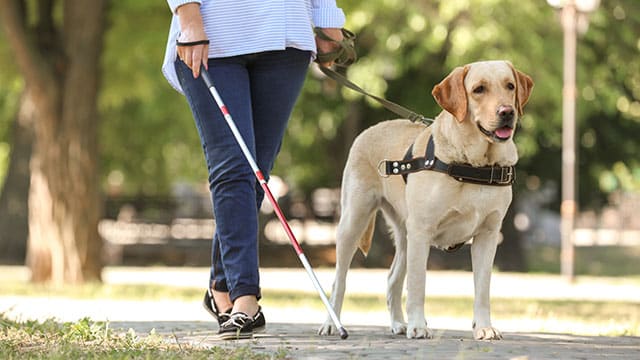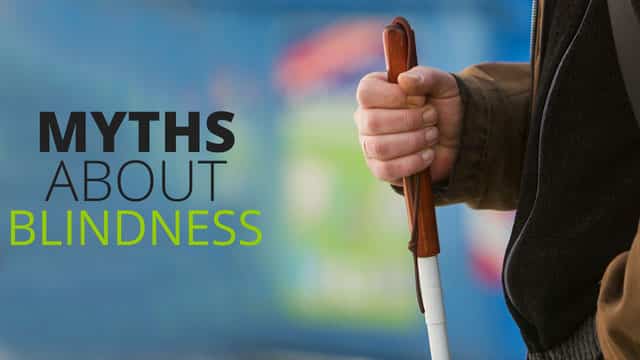Myth #1: People who are blind gain super hearing and other enhanced abilities.
Unfortunately, people who are blind or visually impaired are not gifted with super powers like Daredevil.
They do not automatically gain a sharper sense of touch, hearing, taste, or smell.
It is a combination of hard work and memory to learn to focus and rely on other senses. To compensate for vision loss, people who are visually impaired learn to adjust by focusing more on hearing, taste, touch, and smell.
Or, on the other hand…
Myth #2: If the person is blind, they must be deaf too.

It is not necessary to raise your voice when talking with a person who is visually impaired.
Unless you have a specific reason to believe the person can’t hear you, use your inside voice. No one likes to be shouted at.
Myth #3: People who are blind are always in total darkness, seeing nothing at all.
According to the World Health Organization, about 253 million people live with visual impairments. Of those, 36 million are blind.
The World Health Organization does not specify how many of those 36 million have no light perception (NLP). Many people who are considered blind can often still distinguish shadows, see forms or shapes, or differentiate between light and dark.
Myth #4: You should avoid using visual language.
When speaking with someone visually impaired you don’t have to completely avoid language such as “see” or “look.”
It is not offensive to use language like, “see you later.”
People who are blind use the same language. But it would be more awkward in a conversation to avoid using words like see, watch, and look.
Myth #5: Guide dogs know where to go and how to get there.

Guide dogs are not like taxi drivers. They do not pick you up and take you to your required location. They cannot tell when the traffic light changes or read signs of stores or bus numbers.
Guide dogs require intensive and extensive training throughout their lives to learn commands to assist in traveling.
Just like any normal dog, training requires repetition, lots of praise, and of course rewards or treats.
The handler, or master, oversees the route and gives the guide dog several commands during the journey. The handler listens to traffic to tell the dog when to cross the street, however, the dog does have traffic training and may refuse if a car is coming.
Myth #6: People who are blind can identify you by your voice.
This may be true for people they are in contact with daily like family members or teachers, but overall most voices sound pretty similar.
Think back to the days before caller ID, were you able to identify every voice that called you?
When approaching a person who is blind or beginning a conversation, it is best to identify yourself first. “Guess who” is not a fun game for individuals who are blind.
Myth #7: Only people who are totally blind use a white cane.
There are various degrees of vision loss, including loss of peripheral vision.
Even if a person has decent central vision they may miss obstacles in their periphery resulting in bumps or falls. People with depth perception issues may have difficulty navigating stairs, curbs, or changes in terrain.
Many people with low vision fear using a white cane because of harsh judgments by others because they aren’t completely blind. As a result, people who could really benefit from using a white cane will avoid using one, to the point of injury, because of what others think about them.
If you see a person with a white cane, don’t jump to conclusions about their level of vision loss, or get upset if they can see more than you assumed.
Myth #8: People who are blind want to feel your face to “see” what you look like.
People who are blind live by the same social conventions as everyone else. If you think having your face groped is weird, you’re right, and a blind person isn’t going to want to have their hands all over someone they aren’t intimately close with either.
Some exceptions could include romantic partners, children with vision loss familiarizing themselves with significant family members, and blind parents getting to know their child’s features.
Myth #9: People who are blind don’t dream.
People who are blind take in the world using their other senses: taste, touch, smell, hearing. They dream just like they live, with various sensory information.
In an issue of Sleep Medicine, Danish researchers analyzed dreams from 11 congenitally blind (blind from birth) people, 14 with later-onset blindness, and 25 sighted controls.
Of the blind participants, 18 percent reported tasting in at least one of their dreams, compared with 7 percent of the sighted. Almost 30 percent reported smelling in their dreams, compared to 15% of the sighted controls.
Despite the sensory differences in dreams, the content of dreams wasn’t much different. The blind and sighted groups both reported social interactions, successes, and failures in their dreams.
Myth #10: People who are blind have limited job opportunities.
It is possible for individuals with visual impairments to get a job in any field or industry that they desire given the correct technology, equipment, training, and support. It may be more difficult, but that doesn’t mean it can’t happen.
People who can put this myth to rest include, Richard Bernstein a Michigan Supreme Court Justice who has been blind since birth, Chef Christine Ha lost most of her vision in her 20s and went on to win MasterChef in 2012, and BBC international journalist Gary O’Donoghue who lost his vision at age 8.
The possibilities are endless. There are visually impaired politicians, judges, CEO’s, teachers, entrepreneurs, chefs, musicians, artists, journalists, athletes, and so much more.
If you’ve ever heard any myths about blindness, or even have a question about blindness be sure to leave a comment below.


People who are blind cannot get a good education. False ! Our daughter graduated with a BA (Hons) Degree in English for Professional Communication ar UCLAN / City University Hong Kong.
Great point!